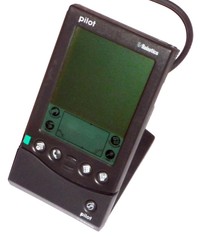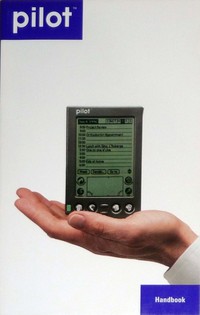US Robotics Pilot 5000
| Home > Browse Our Collection > Computers > 3COM > US Robotics Pilot 5000 |
|
This is the original Pilot model. It's so old it actually says "U.S. Robotics" on it. It holds half a meg of RAM and has the basic computing power of a Macintosh SE. There's no backlight. Palm became a subsidiary of 3Com when U.S. Robotics was acquired by 3Com. In June 1998, the founders became unhappy at the direction in which 3Com was taking the company, and they left and founded Handspring. The Pilot 1000 and Pilot 5000 were early Palm PDAs produced by Palm, Inc. (then a subsidiary of U.S. Robotics). It was introduced in March 1996. The Pilot uses a Motorola 68328 processor at 16 MHz, and had 128 KB (Pilot 1000) or 512 KB (Pilot 5000) built in memory. The PDA has a plastic case (various colours). Its dimensions are 120x80x18 mm and weight is 160 grams. The Pilot has a 160x160 pixel monochrome LCD tactile panel, with a "Graffiti input zone" presented in the bottom third of the screen. Underneath the screen sits a green on/off button, four applications buttons (Date Book, Address Book, To Do List, and Memo Pad) and two scroll buttons. At left, contrast control. At right top, stylus slot. On the back of the device there is a Memory Slot door, Reset button, battery compartment (held two AAA batteries) and Serial Port (for use with the PalmPilot Cradle). Memory is kept in a "memory slot" under a plastic cover at the back top of the PDA. A 512 KB ROM chip stores the Palm OS 1.0 and resident applications. RAM is available in 128 KB, 512 KB or 1 MB; with a PalmPilot Professional memory card, up to 2 MB of RAM. Hardware limit is 12 MB of RAM and 4 MB of ROM. Designed by U.S. Robotics, the diminutive Pilot comes with a powerful suite of pen-based organizer applications and a unique cradle that connects to your PC, making it a snap to keep your data in sync. The more you use it, the more the Pilot becomes a natural extension of your PC. . . . It measures only 4.7 by 3.2 by 0.7 inches and weighs 5.5 ounces. It slips easily into a shirt pocket and is slim enough to fit comfortably in even small hands. About the only criticism that can be levelled at the hardware configuration is that the desktop connection requires a dedicated serial port—a scarce commodity on some systems. The Pilot's 3.4-inch monochrome screen is readable in nearly all conditions, except direct sunlight. Although the display feels small, the Pilot's software makes efficient use of the limited screen real estate with a clean, uncluttered interface and a bold, easily readable typeface. With a footprint slightly smaller than that of a 3.5-inch floppy disk, the cradle holds the Pilot securely and connects it to your PC. To synchronize, simply slip the Pilot into the cradle and press the HotSync button in the lower-right-hand corner. . . . The Pilot is an innovative entry in the world of handheld computing Release Date: June, 1996 Our Pilot5000 with the serial number of 604718561276 is complete with the original packaging, manuals, software and was very kindly donated by Jeff Bronks. Manufacturer: US Robotics Comment on This Page Magazines RELATED to US Robotics Pilot 5000 in our Library
This exhibit has a reference ID of CH26490. Please quote this reference ID in any communication with the Centre for Computing History. |
|














